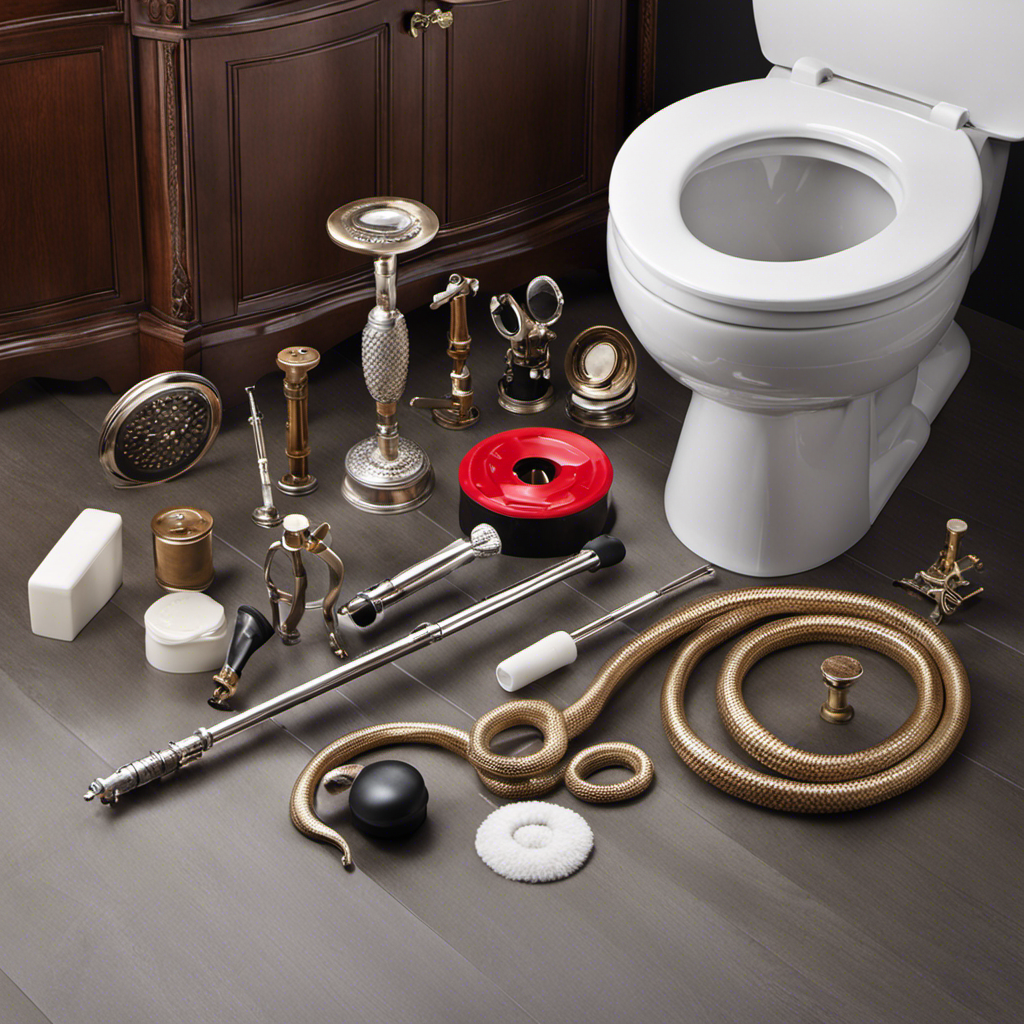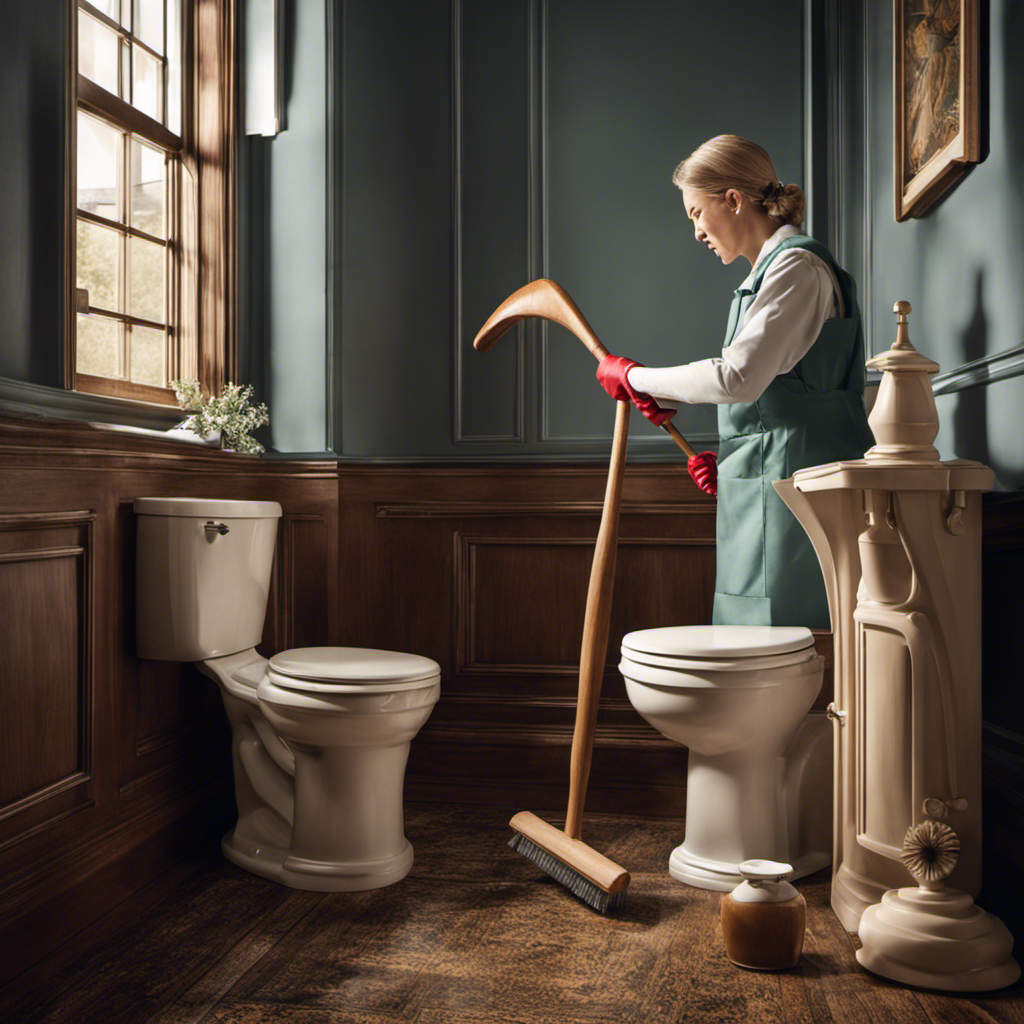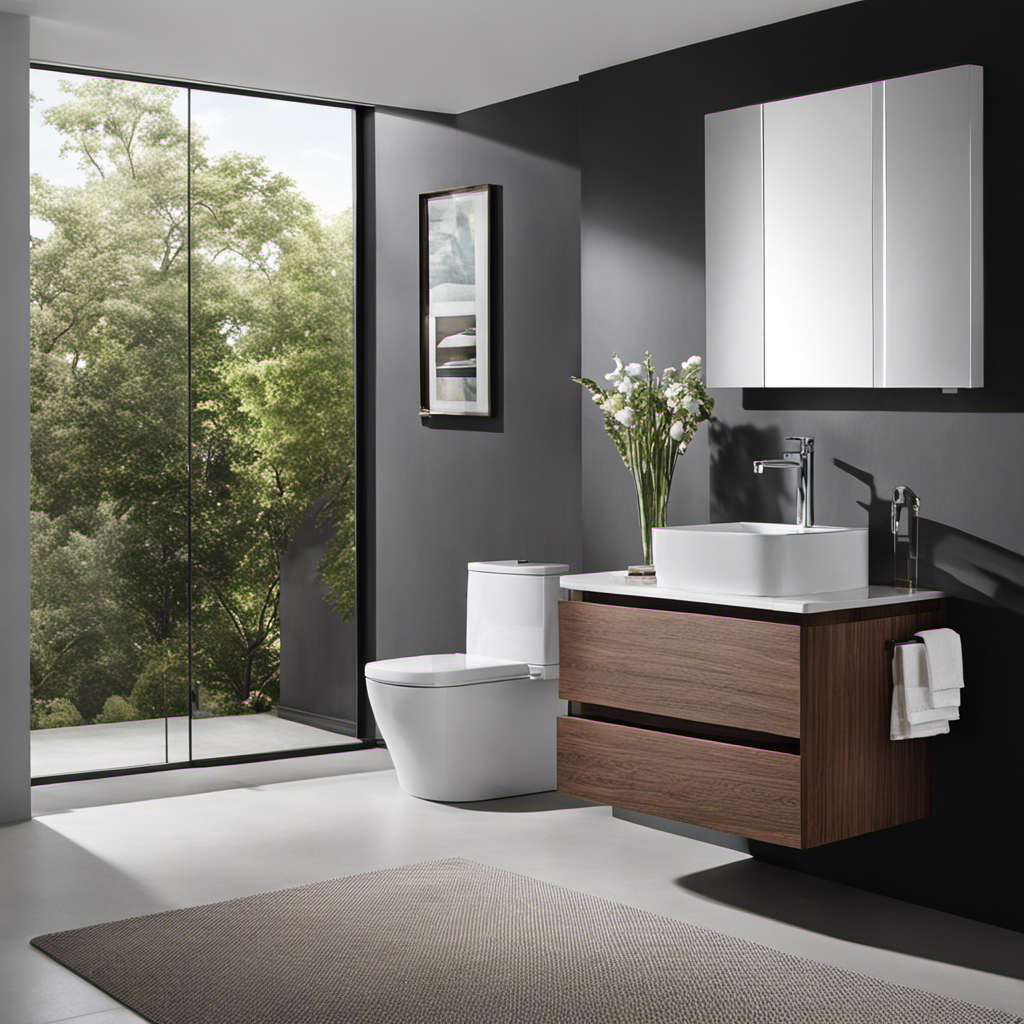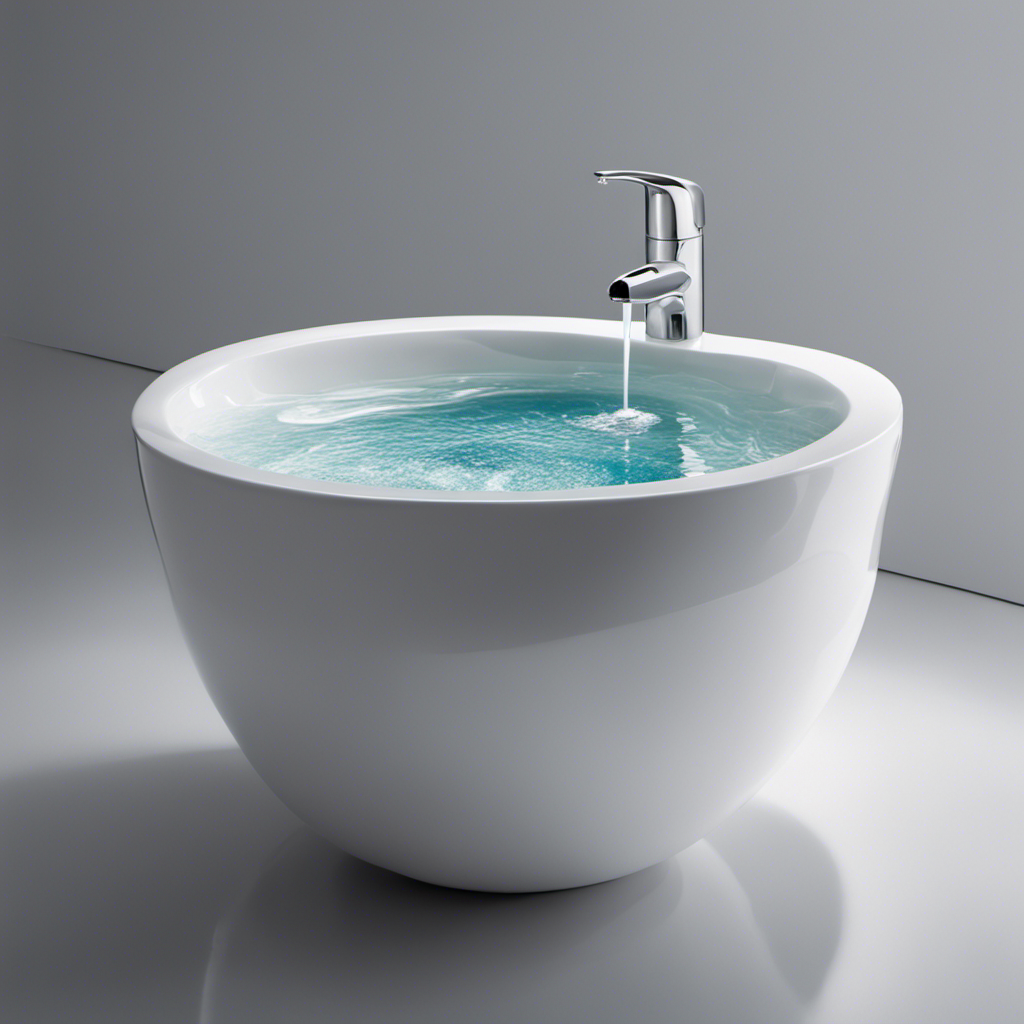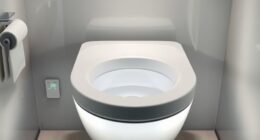Ever wondered what to do when faced with a clogged toilet? Well, I’ve got you covered.
In this article, I’ll reveal the secrets to unclogging a toilet using various techniques. From the trusty plunger to the powerful plumbing snake, I’ll explain each method step-by-step.
So get ready to tackle those stubborn clogs and say goodbye to toilet troubles. Let’s dive in and explore what can be done to unclog a toilet once and for all.
Key Takeaways
- Plunger is a simple and effective tool for unclogging a toilet.
- Alternative methods include using baking soda and vinegar, hot water and dish soap, or enzyme-based cleaners.
- Hot water and dish soap method is highly effective and easy to use.
- Baking soda and vinegar method is effective in breaking down clogs and clearing the toilet drain.
Plunger
You can use a plunger to unclog a toilet. A plunger is a simple yet effective tool for clearing toilet blockages. It consists of a rubber suction cup attached to a wooden or plastic handle.
To use a plunger, place the suction cup over the drain hole in the toilet bowl and push down firmly. Then, quickly pull up to create suction and dislodge the clog. Repeat this motion several times until the water starts to drain freely.
For stubborn clogs, you may need to use a toilet brush to break up the blockage before using the plunger.
It’s important to note that using a chemical drain cleaner is not recommended as it can damage the plumbing system and harm the environment.
Toilet Auger
To unclog a toilet, it’s common to reach for a toilet auger. However, there are alternative methods that can be used if you don’t have a toilet auger or prefer not to use one. Here are four options to consider:
-
Plunger: A plunger is a classic tool for unclogging toilets. It creates suction and pressure to dislodge the clog.
-
Baking Soda and Vinegar: Mix equal parts baking soda and vinegar, then pour it into the toilet bowl. Let it sit for a few minutes before flushing. The chemical reaction can help break up the clog.
-
Hot Water and Dish Soap: Pour hot water and a few squirts of dish soap into the toilet bowl. Let it sit for a few minutes, then flush. The hot water and soap can help soften and loosen the clog.
-
Enzyme-based Cleaners: These cleaners contain natural enzymes that break down organic matter. Follow the instructions on the packaging to use them safely.
While a toilet auger is a reliable option, these alternatives can be effective as well. Now, let’s discuss using hot water and dish soap to unclog a toilet.
Hot Water and Dish Soap
Using hot water and dish soap can be an effective method to soften and loosen a clog in the toilet. This method is simple and affordable, making it a popular choice for many homeowners. To better understand its effectiveness in comparison to alternative methods, let’s take a look at the following table:
| Method | Effectiveness Rating | Cost | Ease of Use |
|---|---|---|---|
| Hot Water and Dish Soap | High | Low | Easy |
| Baking Soda and Vinegar | Medium | Low | Moderate |
| Plunger | High | Low | Easy |
| Toilet Auger | High | Medium | Moderate |
| Chemical Drain Cleaners | High | High | Moderate |
As you can see, the hot water and dish soap method is highly effective and easy to use, while being cost-effective. However, if this method does not work for your clog, the next section will discuss an alternative method using baking soda and vinegar.
Baking Soda and Vinegar
When it comes to unclogging a toilet, one method that is often recommended is using a combination of baking soda and vinegar. This method is known for its effectiveness in breaking down clogs and clearing the toilet drain.
However, it is important to consider some safety precautions before attempting this method. First, make sure to wear protective gloves and eyewear to prevent any contact with the chemicals. Additionally, ensure proper ventilation in the bathroom to avoid inhaling any fumes.
Taking these safety precautions will help ensure a successful and safe unclogging process.
Effectiveness of Method
You’ll find that plunging is the most effective method for unclogging a toilet. When comparing its effectiveness to other methods, such as using baking soda and vinegar or using a toilet auger, plunging comes out on top. Here’s why:
-
Plunging creates a powerful force that dislodges the clog. The up-and-down motion creates pressure changes that push the blockage through the pipe.
-
Plunging is a cost-effective solution. A basic plunger is inexpensive and readily available at most stores. It requires no additional materials or chemicals, saving you money in the long run.
-
Plunging is a quick and efficient method. With a few well-executed plunges, the clog can often be cleared within minutes, allowing you to get back to using your toilet without delay.
-
Plunging is a simple DIY solution. It doesn’t require any special skills or expertise. Just follow the proper technique, and you’ll be able to tackle most toilet clogs effectively.
Safety Precautions to Consider
To ensure your safety while attempting to clear a clog, remember to wear protective gloves and avoid using excessive force. It is important to take safety measures seriously when dealing with clogged toilets. Protective equipment such as gloves can prevent direct contact with potentially harmful substances. Additionally, using excessive force can cause damage to the toilet or the plumbing system. Here are some safety measures to consider:
| Safety Measures | Protective Equipment |
|---|---|
| Wear protective gloves | Rubber gloves |
| Avoid using excessive force | Plunger or toilet auger |
| Use proper ventilation | Face mask |
Enzyme-Based Drain Cleaner
When it comes to effective clog removal, one solution that stands out is the use of enzyme-based drain cleaners. These cleaners are not only natural and eco-friendly but also safe for plumbing systems.
Effective Clog Removal
If your toilet is clogged, try using a plunger to effectively remove the clog. Here are four steps to unclog your toilet like a pro:
-
Position the plunger: Place the rubber cup over the drain hole, ensuring a tight seal.
-
Apply pressure: Push the plunger downwards firmly, then pull up quickly. Repeat this motion several times.
-
Check for results: Flush the toilet to see if the clog is cleared. If not, repeat the plunging process.
-
Prevent future clogs: Avoid flushing excessive toilet paper or flushing non-flushable items like wipes or feminine products.
By following these steps, you can easily unclog your toilet without the need for a professional plumber.
Once you have successfully removed the clog, you can explore natural and eco-friendly methods to maintain a clog-free toilet.
Natural and Eco-Friendly
For a more environmentally friendly option, consider using baking soda and vinegar to prevent clogs in your toilet. These natural remedies are effective DIY alternatives to harsh chemical cleaners.
To use this method, start by pouring half a cup of baking soda into the toilet bowl. Next, pour a cup of vinegar slowly into the bowl. The mixture will create a fizzing reaction that helps break down any clogs or debris.
Let the mixture sit for about 30 minutes, allowing it to work its magic. Finally, flush the toilet to see if the clog has been cleared. Baking soda and vinegar are not only safe for the environment, but they are also gentle on your plumbing.
Give this natural remedy a try before reaching for chemical solutions.
Safe for Plumbing Systems
To protect your plumbing system, it’s important to use safe and gentle alternatives like baking soda and vinegar to prevent clogs. Using natural and eco-friendly methods not only ensures the longevity of your pipes but also eliminates the need for harsh plumbing chemicals.
Here are four DIY methods that are safe for your plumbing system:
-
Baking Soda and Vinegar: Mix 1/2 cup of baking soda with 1/2 cup of vinegar and pour it down the drain. Let it sit for 30 minutes, then flush with hot water.
-
Hot Water: Boil a kettle of water and pour it directly into the toilet bowl. The hot water can help break down the clog and clear the pipes.
-
Plunger: Use a plunger to create suction and dislodge the clog. Make sure to cover the entire drain opening and plunge vigorously.
-
Plumbing Snake: Insert a plumbing snake into the toilet drain and twist it to break up the clog. Pull it out slowly, along with the debris.
Plumbing Snake
You can use a plumbing snake to quickly and effectively unclog a toilet. A toilet snake, also known as a drain auger, is a flexible tool designed to remove clogs from pipes. It consists of a long metal cable with a handle at one end and a coiled spring or auger at the other. To use a toilet snake, you simply insert the coiled end into the toilet drain and rotate the handle to break up and remove the clog. Here is a table that compares the benefits of using a toilet snake for clog removal:
| Toilet Snake | Benefits |
|---|---|
| Quick and effective | Removes clogs efficiently |
| Versatile | Can be used for various types of clogs |
| Affordable | Cost-effective solution |
| Easy to use | Requires minimal effort and expertise |
| Safe for plumbing | Does not damage pipes or toilet |
Using a plumbing snake is a reliable and efficient method to unclog a toilet. However, if you prefer an alternative option, you can also consider using a wet/dry vacuum.
Wet/Dry Vacuum
After exploring the option of using a plumbing snake to unclog a toilet, let’s move on to another alternative method: the wet/dry vacuum. This versatile tool can be a great asset when dealing with stubborn clogs. Here’s why it’s worth considering:
-
Strong suction power: A wet/dry vacuum can generate powerful suction, capable of removing even the toughest blockages from the toilet drain.
-
No mess: Unlike plunging, using a wet/dry vacuum eliminates the risk of splashing dirty water all over the bathroom. The vacuum efficiently removes the clog without any mess.
-
Versatility: Besides unclogging toilets, a wet/dry vacuum can also be used for various cleaning tasks, making it a useful tool to have around the house.
-
Quick and efficient: With the right attachments, a wet/dry vacuum can clear a clog in no time, allowing you to get back to using your toilet without any delays.
While the wet/dry vacuum may not be the first method that comes to mind, it is definitely worth considering as an effective alternative for unclogging a toilet.
Frequently Asked Questions
Can I Use a Plunger on a Clogged Sink or Bathtub Drain?
Yes, you can use a plunger on a clogged sink or bathtub drain. However, if you’re looking for plunger alternatives or DIY drain cleaning methods, there are other options to consider.
Is It Safe to Use Hot Water and Dish Soap to Unclog a Toilet?
Using hot water and dish soap to unclog a toilet can be effective. The heat from the water helps to break down any clogs, while the soap acts as a lubricant. However, caution must be taken to avoid further damage.
Can Baking Soda and Vinegar Unclog a Severely Clogged Toilet?
Baking soda and vinegar can be used as alternatives to unclog a severely clogged toilet. However, if these methods fail, it is recommended to seek professional assistance for more effective and reliable unclogging techniques.
How Long Does It Usually Take for Enzyme-Based Drain Cleaner to Work?
Enzyme-based drain cleaners typically take 24-48 hours to work effectively. If you’re looking for alternative methods to unclog a toilet, consider using a plunger or a plumbing snake for quicker results.
Can a Wet/Dry Vacuum Be Used to Unclog a Toilet?
Yes, a wet/dry vacuum can be used as an alternative for unclogging a toilet. However, there are pros and cons to consider. It can be effective in removing clogs, but may cause damage if not used correctly.
Conclusion
In conclusion, when faced with a clogged toilet, there are several effective tools and methods at your disposal.
The trusty plunger, with its strong suction, is a reliable option for most blockages.
For stubborn clogs, a toilet auger can be used to reach deep into the drain and break up the obstruction.
Hot water and dish soap can provide a gentle yet effective solution, while the powerful combination of baking soda and vinegar can create a fizzing reaction to dislodge the blockage.
Enzyme-based drain cleaners are another option, as they work to break down organic matter.
Lastly, a plumbing snake or a wet/dry vacuum can be used for more serious clogs.
Remember, with the right tools and techniques, you can tackle any clog and restore your toilet to its pristine condition.
